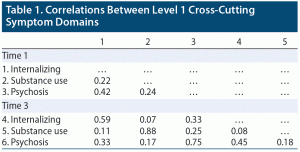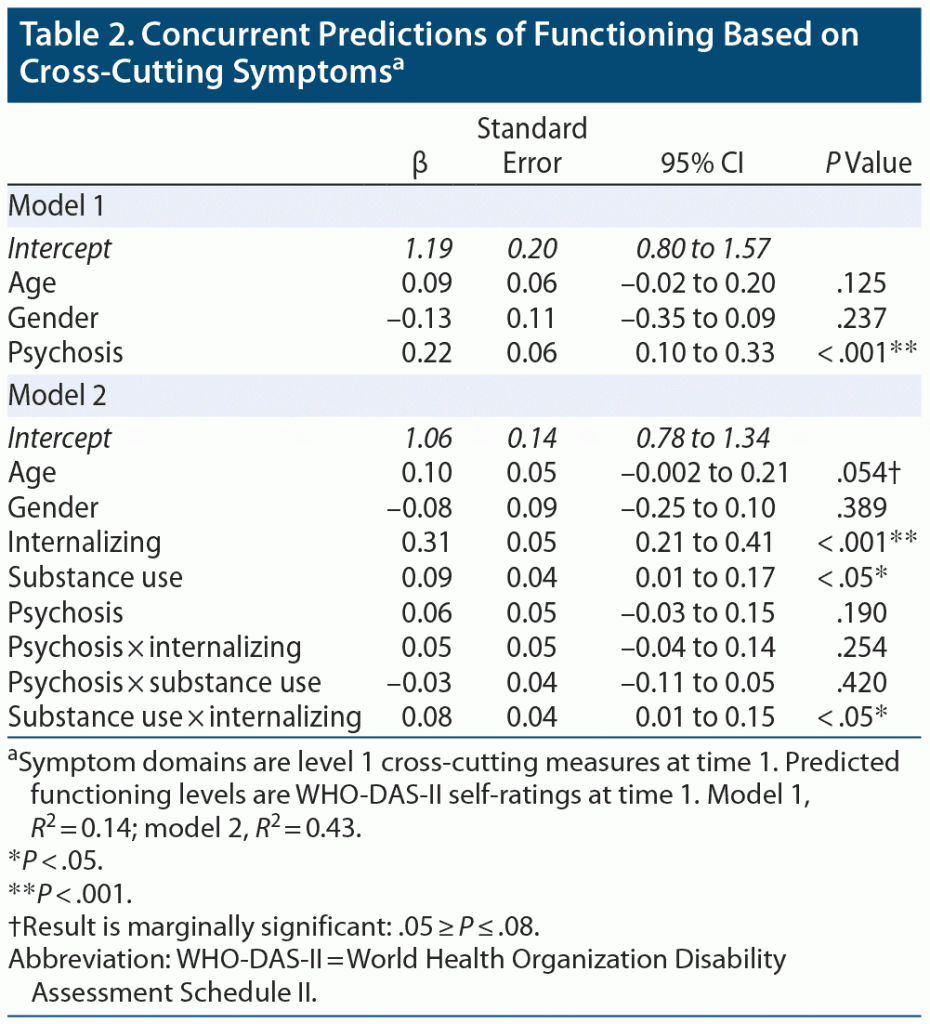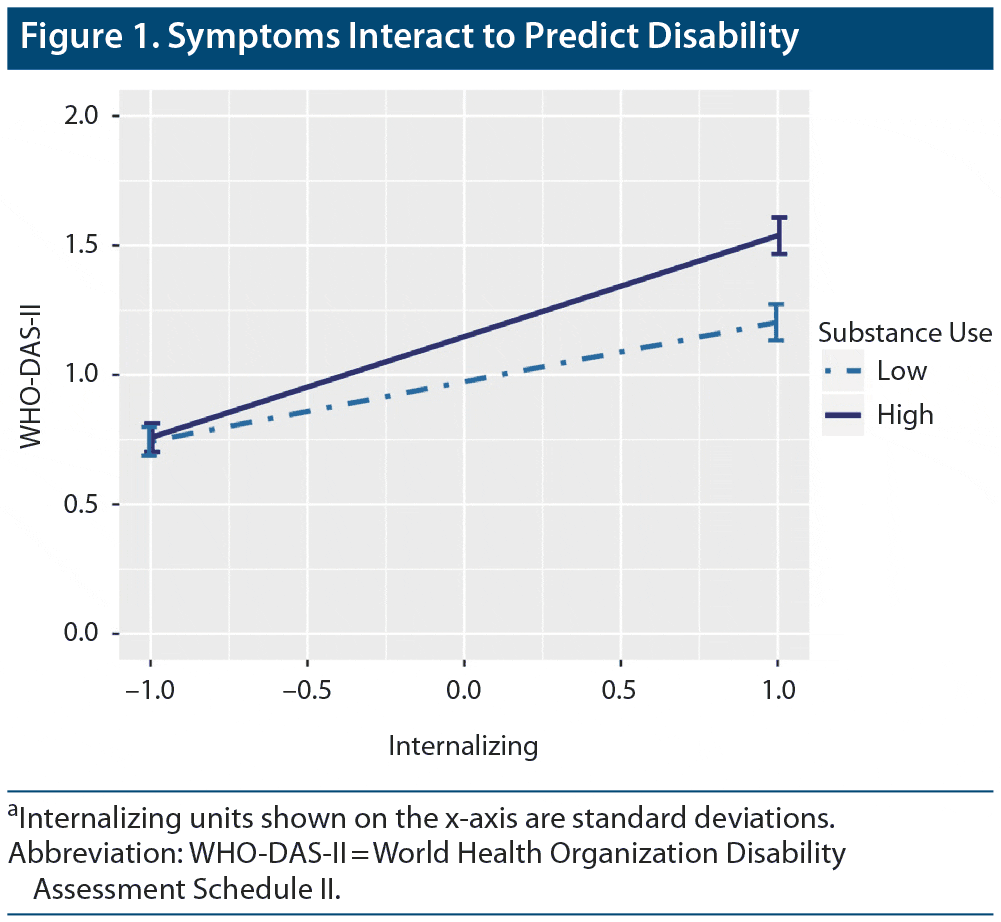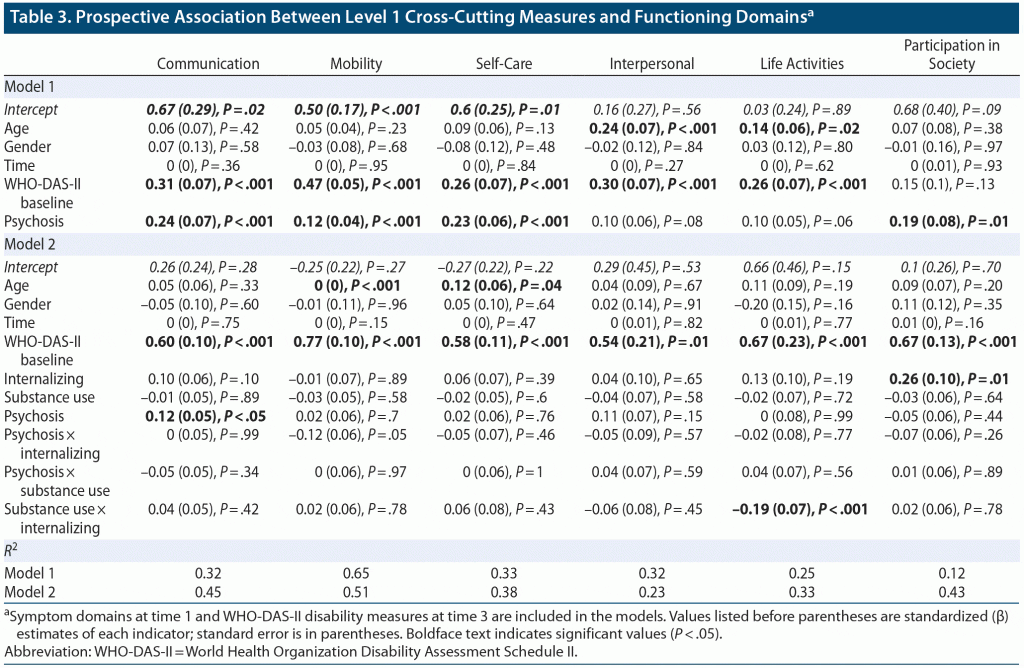
ABSTRACT
Objective: Previous research shows elevated disability in psychotic disorders. However, co-occurring symptomatology has been increasingly highlighted as predictive of clinical outcomes in the psychotic spectrum. The current study investigates how both psychotic and nonpsychotic symptom domains predict functioning across psychotic disorders.
Methods: Outpatients (N = 128) with psychotic spectrum diagnoses participated in the Diagnostic and Statistical Manual for Mental Disorders, Fifth Edition (DSM-5) Field Trials at the Centre for Addiction and Mental Health in Toronto, Canada, in 2011, including the repeated administration of “cross-cutting” brief screening measures that assessed internalizing (eg, anxiety, depression), substance use (eg, alcohol, psychoactive drug use), and psychotic symptoms. Level of functioning was also assessed by self-report and clinician-rated World Health Organization Disability Assessment Schedule 2.0 (WHO-DAS-II). The relation between symptom domains and disability was examined concurrently and prospectively via hierarchical regression.
Results: Psychosis was strongly linked to self-reported disability when considered in isolation (β = 0.22, P < .001; R2 = 0.11). However, when all 3 symptom domains were included in analyses, internalizing symptoms were the strongest concurrent (β = 0.31, P < .001; R2 = 0.17) and prospective (β = 0.29, P < .001; R2 = 0.15) predictor of disability. In the concurrent model, an interaction between internalizing and substance use emerged, wherein high internalizing symptoms were particularly detrimental in persons with high levels of substance use (β = 0.08, P < .05; R2 = 0.014). Results were similar for clinician-rated WHO-DAS-II.
Conclusions: This research supports the potential clinical utility of rapid screening tools available in the newest psychiatric diagnostic manual. The internalizing symptom domain was the strongest predictor of functional outcome for outpatients with psychotic disorders. The results highlight the relevance of a broad range of symptoms, including those that fall outside the primary psychiatric concern, in recovery-oriented clinical work in psychosis.
J Clin Psychiatry 2021;82(2):20m13288
To cite: Longenecker JM, Bagby RM, McKenzie K, et al. Cross-cutting symptom domains predict functioning in psychotic disorders. J Clin Psychiatry. 2021;82(2):20m13288.
To share: https://doi.org/10.4088/JCP.20m13288
© Copyright 2021 Physicians Postgraduate Press, Inc.
aCampbell Family Mental Health Research Institute, CAMH, Toronto, Ontario, Canada
bUniversity of Minnesota, Minneapolis, Minnesota
cUniversity of Toronto, Toronto, Ontario, Canada
dCurrent affiliation: VISN 4 Mental Illness Research, Education and Clinical Center (MIRECC), VA Pittsburgh Healthcare System, Pittsburgh, Pennsylvania
*Corresponding author: Lena C. Quilty, PhD, 1025 Queen St W, Ste 6405, Toronto, ON, M6J 1H1 ([email protected]).
Psychotic disorders are associated with substantial impairment in everyday functioning.1 A primary goal in modern treatment of psychotic disorders is to promote functional recovery.2 Research has progressively established that negative symptoms (eg, avolition) predict functional disability levels more strongly than positive symptoms of psychosis3 (ie, hallucinations and delusions). The relationship between disability levels and symptoms that frequently co-occur with psychotic disorders has received less attention. Our goal was to identify the extent to which comprehensive symptom screening measures available in the online materials for the latest edition of the Diagnostic and Statistical Manual for Mental Disorders, Fifth Edition (DSM-5)4 relate to the functional outcomes of individuals with psychotic disorders. By considering this question in the context of broadly characterized symptom domains measured at multiple time points, we may identify clinical factors that lie outside diagnostic criteria for the patients’ primary psychiatric concerns yet lead to disruption in their daily lives.
Recovery is a multifaceted treatment goal, in which clinical state and functioning are core components. Almost half of persons with schizophrenia spectrum disorders experience symptom remission, whereas about a quarter achieve functional recovery.5 A mere 13.5% of persons with schizophrenia and related psychotic disorders improve in both domains.6 Recovery rates reflect the enduring and pervasive nature of functional disability and the distinct nature of psychotic symptom severity versus functioning and disability. The course of illness results in enormous individual suffering and one of the largest global economic burdens.7 Identifying symptoms that longitudinally predict functioning will help to develop and deliver interventions attentive to symptom remission and holistic recovery.
Clinical, cognitive, and environmental factors have been linked to disability in psychosis.8 The relationship between positive symptoms, the definitive core of psychotic disorders, and functional impairment is surprisingly modest. Rather, co-occurring diagnoses are an important focus in the treatment of psychotic disorders given their pervasiveness, link to poorer outcome, and high global disease burdens.7,9 Depression and substance abuse, with estimated prevalence rates of 50% in schizophrenia, have been independently established as predictors of higher disability.10,11 Depression and cognitive deficits similarly predict poor functional outcome.8 Less attention has been given to symptoms outside depression, however, or the way in which symptom domains interact. Practice guidelines recommend assessing a wide scope of symptoms within and outside the presenting complaint, but there are limited empirical models of how symptom domains jointly contribute to recovery from psychotic disorders.
Scales focusing on the diagnostic criterion of schizophrenia (eg, Positive and Negative Syndrome Scale)12 and clinician-administered instruments (eg, Brief Psychiatric Rating Scale)13 are commonly administered symptom measures in studies of psychotic disorders.1 Adopting broader symptom assessment and patient perspectives via brief screening instruments will expand our understanding of functioning. Empirical work shows that much of psychopathology is captured by 3 higher-order domains (for example, work by Wright and Krueger)14 situated within a broader hierarchical taxonomy: internalizing (eg, anxiety and depression), externalizing (eg, substance use and antagonism), and psychosis (eg, positive symptoms, but referred to as thought disorder in some models). These 3 domains emerge consistently across diagnosis, culture, gender, and age.15–19 Limited research has connected psychosis or the trifactor model to functional outcome measures.20 Given the strong evidence that symptoms outside the psychosis domain are prominent and contribute to functional impairment in psychosis, it is important to simultaneously incorporate all 3 domains in models.
In the current study, our primary objective was to evaluate the association between symptoms associated with externalizing, internalizing, and psychosis domains and functioning in outpatients with psychotic spectrum diagnoses. We utilized the DSM-5 Field Trials data collected in Toronto, Canada, which incorporate a large number of outpatients with schizophrenia spectrum disorders, inclusive eligibility criteria (ie, no attempts were made to screen out those with comorbid psychiatric problems), and a naturalistic prospective design. The current investigation will extend the body of literature linking specific symptom domains to outcome in severe mental illness, which to date has chiefly focused upon the psychosis factor in isolation21 or as part of a general psychopathology factor.22 This investigation will simultaneously evaluate the clinical utility of the brief assessment instruments included in the DSM-5 (ie, Level 1 Cross-Cutting Symptom Measure)23 and connect them to a validated functional disability measure, the World Health Organization Disability Assessment Schedule 2.0 (WHO-DAS-II).24 A broad examination of clinical predictors of real-world functioning in outpatients with psychotic disorders will be beneficial to conceptualizing the relationship between symptoms and functional adjustment and identifying targets of recovery-oriented clinical work. Our main hypothesis was that psychosis symptoms would significantly predict WHO-DAS-II when they were the only symptom domains in the model. However, we expected the effect of psychosis to diminish when internalizing and substance use were simultaneous predictors. Likewise, substance use was not expected to be a significant predictor of functioning due to the comparatively large effect of internalizing symptoms.25 We hypothesized that internalizing would be the strongest and most enduring predictor of functional disability, based on the role of depressive symptoms in recovery from schizophrenia and the association between internalizing and outcome in other disorders.8,26
METHODS
Participants
Participants included in the current study were a subset of those recruited for the DSM-5 Field Trials at the Centre for Addiction and Mental Health (CAMH) site in Toronto, Ontario, Canada, from February to October 2011. The larger DSM-5 Field Trials sample (N = 242) was constructed using stratified random sampling. A portion of the sample was recruited as part of a diagnostically heterogeneous psychiatric control group (N = 114); these participants did not have a history of psychotic disorders and were excluded from the current study. Approximately half the sample (N = 128) was recruited with a focus on enrolling persons with a history of schizophrenia spectrum disorders and was included in the current analysis (63 schizophrenia, 43 schizoaffective disorder, 2 delusional disorder, 10 psychosis not elsewhere classified, 1 schizophreniform, 1 brief psychotic disorder, 7 attenuated psychosis syndrome, 1 substance-induced psychosis). Inclusion criteria were current symptoms for a DSM-IV schizophrenia spectrum diagnosis, age of 18 years or older, ability to communicate in English, and no impairment of cognition or capacity that would preclude study participation.
Participants were ages 26 to 84 years (µ = 40.72, SD = 13.35). Most participants (n = 72; 56%) had at least 1 comorbid diagnosis. The comorbid diagnoses were 30, mood; 28, anxiety; 27, substance abuse; 6, trauma; 5, obsessive-compulsive; 5, personality; 1, neurodevelopmental; 1, somatic; and 1, feeding and eating disorder; many individuals exhibited more than 1 comorbid disorder (µ DSM-5 diagnoses = 2.00, SD = 1.24, maximum = 6). Diagnoses were determined by psychiatrists, clinical psychologists, psychiatrists, or psychiatric residents using interviews and DSM-5 diagnostic checklists. The majority (80%) of participants were taking antipsychotic medications. Of the 11 who were not, all but 2 had a prescription for an antidepressant, mood stabilizer, and/or sedative; 14 were missing medication data. The study included 3 visits: time 1, time 2 (4 hours to 2 weeks later), and time 3 (4 to 12 weeks later); the current analyses will utilize time 1 and time 3 assessment measures only for concurrent and prospective analyses (see below). Full study procedures were described in the first DSM-5 Field Trials seminal papers.23,27,28 The study was approved by the local ethics committee, and written informed consent was obtained from all participants.
Measures
Participants completed the DSM-5 Level 1 Cross-Cutting Symptom Measure, a brief self-report instrument that assesses 13 psychiatric domains over the last 2 weeks with 23 items rated from 0 (none) to 4 (severe/nearly every day). All 23 items were included in the total score, consistent with standard scoring procedures. The Level 1 Cross-Cutting Symptom Measure covers a broad range of psychiatric difficulties, including the 3 fundamental symptom domains described above (ie, internalizing, externalizing, and psychosis).29 We selected at least 3 level 1 items as the best indicators of each domain based on recent reviews and those symptoms most robustly associated with each domain.14 Certain domains (eg, somatic symptoms) have received limited empirical evaluation according to this model of psychopathology or often coload on multiple domains (eg, mania) and were, therefore, not included in the calculation of these domains. The internalizing domain includes 6 items assessing anxiety, depression, and suicidal ideation (items 1, 2, 6, 7, 8, and 11). The substance use domain includes 3 items (items 21, 22, and 23) that assess problematic alcohol, psychoactive drug, and tobacco use. The psychosis domain includes 2 self-rated items (items 12 and 13) assessing thought broadcasting and auditory hallucinations. Given this limited coverage in the patient-rated level 1 measure, we further included the single clinician-rated item assessing overall delusions, hallucinations, and disorganized speech. Specifically, clinical interviewers completed a select portion of level 1 cross-cutting measure ratings, including an overall rating of psychotic symptom severity at level 1, which we included to ensure sufficient coverage of this critical domain. Level 1 cross-cutting measures were collected at all time points. Test-retest reliability between time 1 and time 2, as quantified by interclass correlation coefficients (ICC), was high for each domain (internalizing ICC = 0.92, substance use ICC = 0.97, psychosis ICC = 0.89). Correlations between the 3 level 1 cross-cutting measure symptom domains at times 1 and 3 are reported in Table 1. Based on potential concerns regarding the overlap between the internalizing domain and negative symptoms, we further derived a measure of negative symptoms using 2 items, restricted emotional expression and avolition, from the clinician-rated Psychosis Checklist. Ratings range from 0 (not present) to 4 (present and severe). Due to data missingness, a supplemental analysis using this negative symptom measure was completed for time 1 only (n = 123).
To assess disability levels, participants completed the WHO-DAS-II, a 36-item self-report scale. Items are rated on a scale ranging from 0 (none) to 4 (extreme/cannot do). Like cross-cutting ratings, items referred to the preceding 2-week period. The scale derives a general disability factor that probes 6 areas of living. In accordance with WHO-DAS-II scoring instructions, scores would have been excluded if more than a quarter of the items were missing within the scale of interest. Clinical staff also rated a 6-item WHO-DAS-II on a scale of 0 to 4.
Analysis
The degree to which internalizing, substance use, and psychosis symptom domains predict functional impairment was examined using hierarchical regression models in Mplus (version 7.3). Robust maximum likelihood estimator accounted for missing data (n = 22) at time 3. First, we examined the relation between clinical state and functioning at time 1 (concurrent models); separate analyses were carried out for clinician- and patient-rated disability. Second, we examined how symptoms at time 1 predicted clinician- and client-rated functioning at time 3 (prospective models). Third, we analyzed how disability subscales are predicted by symptom domains at times 1 and 3. Age and gender were included as covariates. In each analysis, the first step of the model included the covariates and psychosis; the second level of the model added the 3 symptom clusters and interactions between the symptom domains. All prospective models included days between the 2 time points as a covariate. For prospective analysis, we also explored the degree to which symptoms predict change in disability by adding initial disability at time 1 as a predictor. All predictors were standardized before inclusion in statistical models.
RESULTS
Concurrent Prediction of Disability
Overall WHO-DAS-II general disability level was mild (µ = 0.97, SD = 0.65) at time 1. Hierarchical regression tested the concurrent effect of symptom domains (Table 2). Step 1 accounted for 14% of the variance in WHO-DAS-II general disability scores. Disability was primarily explained by psychosis, with more severe psychotic symptoms predicting greater disability (β = 0.22, P < .001; R2 = 0.11). The second step accounted for significantly more variance in disability (∆R2 = 0.28). Notably, the main effect of psychosis was no longer significant, and internalizing was most strongly associated with disability levels (β = 0.31, P < .001; R2 = 0.17). A small main effect of substance use (β = 0.09, P < .05; R2 = 0.015) and an interaction between substance use and internalizing (β = 0.08, P < .05; R2 = 0.014) were also observed.a The interaction indicated that general disability was comparable in those with low internalizing regardless of substance use and highest in those with both high substance use and high internalizing (Figure 1). The moderation was significant when substance use was above −1.95 standard deviations from the mean (simple slopes at 0: b = 0.31[0.05], t = 6.08, P < .05). To further characterize the internalizing domain, we added the clinician-rated negative symptom measure to the model. Negative symptoms were not significant in either level of the model, and the relationship between disability and the other symptom domains remained the same (Supplementary Table 1).
Clinician-rated and self-reported WHO-DAS-II disability levels were highly correlated (r = 0.60, 95% CI [0.43 to 0.72], P < .001). Clinician-rated overall disability was explained by psychosis in the first step (β = 1.5, P < .001; R2 = 0.15). With all symptoms in the second step, internalizing (β = 1.6, P < .001; R2 = 0.13) and psychosis (β = 0.93, P < .05; R2 = 0.04) predicted overall disability; age and the interaction between substance use and internalizing were at the threshold of significance. The 6 subscales of WHO-DAS-II showed a similar pattern (Supplementary Table 2), with psychosis predicting disability of all subscales in the first level of the hierarchical model (β = 0.15–0.32, P < .05; R2 = 0.08–0.17) except self-care, which was at the threshold of significance (β = 0.13, P = .05; R2 = 0.05). The full models explained more of the variance in disability scores (∆R2 = 0.11–0.25). Internalizing predicted disability across all subscales. Substance use predicted self-care and interpersonal functioning (β = 0.12, P < .05, R2 = 0.17; β = 0.18, P < .05, R2 = 0.10), while the interaction between internalizing and substance use predicted mobility and interpersonal functioning (β = 0.11, P < .05, R2 = 0.31; β = 0.13, P < .05, R2 = 0.09). Psychosis solely predicted participation in society (β = 0.14, P < .05; R2 = 0.12).
Prospective Prediction of Disability
Participants completed the third assessment a mean of 46.77 (SD = 17.17, range: 28–126) days after the initial visit. As in the concurrent analysis, more severe overall symptoms and older age at time 1 were prospectively associated with poorer functioning at time 3. In a hierarchical regression model, the 3 symptom domains at time 1 accounted for 19% of the variance in general disability scores at time 3. In step 1, higher levels of psychosis were associated with greater disability (β = 0.20, P < .05; R2 = 0.11). Age accounted for a small portion of variance (β = 0.17, P < .05; R2 = 0.08). The second step accounted for more variance in general disability (∆R2 = 0.17) and indicated internalizing was the best predictor of disability levels (β = 0.29, P < .001; R2 = 0.15). Age remained positively predictive of general disability (β = 0.18, P < .05; R2 = 0.06). The effect of internalizing decreased to marginal significance after accounting for disability at time 1 (β = 0.11, P = .069; R2 = 0.02; Supplementary Table 3). Convergence between client and clinician WHO-DAS ratings was weaker, though still significant, at time 3 (r = 0.41, 95% CI [0.20 to 0.58], P < .001). As with client-rated disability, clinician ratings of disability were most strongly associated with internalizing symptoms in prospective analyses (β = 1.09, P < .05; R2 = 0.28). The interaction between internalizing and substance use was marginally significant. Unlike self-reported WHO-DAS-II analyses, the interaction between psychosis and substance use was significant (β = –0.73, P < .05; R2 = 0.28).
Lastly, we considered how the symptom domains predicted disability subscales at time 3. Accounting for overall disability at time 1 revealed unique relationships between symptom domains and subscales (Table 3). In isolation, psychosis was significant for 4 subscales and at the threshold of significance for interpersonal functioning and life activities (β = 0.10, P = .08; β = 0.10, P = .06). When other symptom domains were added to the model, WHO-DAS-II baseline scores predicted all 6 subscales. Internalizing was only predictive of participation in society (β = 0.26, P < .05; R2 = 0.10). The interaction between substance use and internalizing predicted life activities (β = –0.19, P < .001; R2 = 0.06). Psychosis remained a significant predictor of 1 subscale, communication and understanding, in the full model (β = 0.12, P < .05; R2 = 0.07).
DISCUSSION
The current work explores the utility of a brief screening measure to identify symptom domains that provide greater predictive validity than broad categorical diagnoses with respect to functional impairment in persons with severe mental illness. The internalizing domain emerges as the strongest predictor of patient and clinician rated disability levels, concurrently and prospectively. Positive symptoms, subsumed in the psychosis domain, are correlated with disability when other symptom clusters are not taken into consideration. However, internalizing has the strongest relationship with WHO-DAS-II disability levels when all 3 symptom domains—internalizing, substance use, and psychosis—are included as simultaneous predictors. The current study elaborates upon existing cross-sectional work in psychosis30,31 and supports a transdiagnostic conceptualization of internalizing symptoms as the most substantial predictor of functioning.26,32
The predominance of research linking symptoms and disability associated with schizophrenia has suggested that general psychopathology is more predictive of quality of life than psychotic symptomatology (ie, positive, negative, and disorganized symptoms).33 We provide evidence that dimensional models of psychopathology have clear utility in characterizing clinical features and predicting functional disability. Internalizing (ie, depression and anxiety) uniquely accounted for functional impairment in a wide variety of psychotic presentations, above and beyond the main diagnostic criterion of schizophrenia spectrum disorders. Identifying specific clinical factors that influence outcome is important given the instability of categorical diagnoses.27 Dimensional models of psychopathology are emerging as reliable and powerful predictors of functional impairment that would overwise be obscured by heterogeneous categorical diagnoses.34
Investigating depression in schizophrenia presents a particular challenge due to the overlap with negative symptoms.35 Like our results, past work has demonstrated that depression and negative symptoms have unique relationships to disability.30,36 This is further supported by the delineation of classic mood disturbance and restricted affect into the internalizing and detachment Hierarchical Taxonomy of Psychopathology (HiTOP) spectra, respectively.34 However, there is considerable debate about how separable the domains are, with recent work suggesting overlap in negative symptom and depressive presentations, particularly avolition, anergia, and anhedonia.35 Careful assessment of the breadth of the domains could guide treatment and mechanistic models of illness progression. For example, one theory put forth is that depression emerges in prodromal stages, serving as a stressor that perturbs predispositional vulnerabilities.37,38 Furthermore, depression may have a transactional relationship with functioning that influences disease progression and relapse such that depressive symptoms exert a greater impact as people with schizophrenia age, as seen in our results.39
Utility of Brief Assessments
Self-report screening tools such as those used in the current study efficiently capture a broad spectrum of symptoms that can guide assessment. The cross-cutting symptom measure shows sensitivity, specificity, and convergent validity with more comprehensive instruments.40 The domains presented here are widely supported by empirically based nosology such as HiTOP.41 Dimensional scoring quantifies severity within multiple domains, which can focus treatment on specific symptoms known to predict decreased functioning. The brevity allows for systematic integration of screening instruments that add reliability to clinical assessment, as has been done in forensic settings,42 without adding undue burden to clinicians or patients.
Limitations and Future Directions
Self-report has the potential for client biases while providing important insight into the subjective experience of individuals experiencing mental illness.43,44 Future studies could incorporate a multiple-method/measurement (ie, informant ratings) approach as the rating source rather than relying on self-report and clinician ratings. Acute and stabilized patients could be included in future work to investigate whether the relationship between symptoms and disabilities is nonlinear, in which case certain domains may have a stronger impact at more severe levels. Further, the relationship between symptoms and disability showed more variation in prospective than concurrent analyses. This variation may reflect numerous components of our sample and research design, such as relatively limited change in certain symptom domains and/or functional outcomes. Future research with longer follow-up periods or specific samples or designs (eg, acute treatment of first-episode psychosis) will offer valuable information on the stability of the association under different clinical contexts. Lastly, the current study takes a theoretically founded, top-down approach to investigating symptom domains. Psychometrically derived models of level 1 cross-cutting measures and empirical examination of level 2 cross-cutting measures will add further understanding of the conditions under which these measures contribute meaningfully to functional outcome.
CONCLUSION
Our findings showcase instruments that are readily accessible in DSM-5 online materials and capture a fine-grained symptom level that is compatible with dimensional conceptualizations of mental illness. We highlight the impactful role affective symptoms play in the trajectory of functional recovery and the clinical utility of rapid assessment tools made publicly available by the American Psychiatric Association to supplement the DSM-5. To our knowledge, this is the first study to investigate how individual differences in internalizing, substance use (ie, externalizing), and psychosis symptoms prospectively predict functional disability in persons with severe mental illness. The findings emphasize the importance of broad assessment of symptoms, including those that fall outside the primary psychiatric diagnostic concern, in recovery-oriented clinical work.
Submitted: February 9, 2020; accepted September 22, 2020.
Published online: February 23, 2021.
Potential conflicts of interest: The authors report no financial or other relationship relevant to the subject of this article.
Funding/support: This research was supported by the American Psychiatric Association, the philanthropic support of Roland Cardy, and the CAMH Foundation.
Role of the sponsor: American Psychiatric Association formulated the study design and contributed operating funds to the DSM-5 Field Trials study design but had no role in interpretation of the evidence. The CAMH Foundation and Roland Cardy provided funding to this work but had no direct role in study design, interpretation, or this manuscript. All stages of manuscript development were at the sole discretion of the authors.
Disclaimer: The contents of this article do not represent the views of the US Department of Veterans Affairs or the United States Government.
Previous presentation: Presented at the Synapse Conference at Upper Canada College; April 24, 2018; Toronto, Ontario, Canada • Canadian Psychiatric Association Annual Meeting; September 27–29, 2018; Toronto, Ontario, Canada.
Acknowledgments: The authors thank all the patients who participated in the DSM-5 Field Trials research at the CAMH site. They also thank the American Psychiatric Association staff who provided clinician training and otherwise supported the implementation of the Field Trial protocols, including David J. Kupfer, MD (University of Pittsburgh, Pittsburgh, PA); Darrel A. Regier, MD, MPH (Uniformed Services University, Bethesda, MD); William E. Narrow, MD, MPH (University of New Mexico, Albuquerque, NM); Diana E. Clarke, PhD, MSc (Johns Hopkins, Baltimore, MD); and Lisa H. Grenier, MSSA (Johns Hopkins, Baltimore, MD). None of the individuals had a conflict of interest with regard to the research project. The authors also acknowledge the substantial efforts of the Field Trial Principal Investigators and their research teams, as well as the DSM-5 work group and study group members.
Supplementary material: Available at Psychiatrist.com.
Clinical Points
- Assessment of severe mental illness should cover depression and anxiety, as well as the main criteria of schizophrenia spectrum disorders.
- Brief symptom assessments consisting of fewer than 25 questions can predict current and future functional impairment in severe mental illness.
- Positive symptoms do not predict functional disability strongly in mixed psychotic disorders, whereas depression and anxiety do.
aAdditional regressions were conducted to ensure the order in which variables were entered did not produce misleading results. Both internalizing and substance use significantly predicted disability when entered as the sole symptom domain in the first step of the model. They remained significant when included as simultaneous predictors (ie, age, gender, internalizing, and substance use as independent variables). The effects also remained significant when the psychosis symptom domain and interactions were added to the model.
We also conducted a post hoc investigation of somatic concerns and mania, which have a limited number of items in the Level 1 Cross-Cutting Measure. Qualitatively, the results held: internalizing was the strongest predictor of WHO-DAS-II general disability. Substance use was at the threshold of significance (β = .15, P = .06), as was an interaction between somatic concerns and substance use (β = .19, P = .06). The consistency between these findings and planned analyses increases our confidence that there is a stable association between internalizing and disability in severe mental illness.
Editor’s Note: We encourage authors to submit papers for consideration as a part of our Focus on Psychosis section. Please contact Ann K. Shinn, MD, MPH, at [email protected].
References (44)

- Świtaj P, Anczewska M, Chrostek A, et al. Disability and schizophrenia: a systematic review of experienced psychosocial difficulties. BMC Psychiatry. 2012;12(1):193. PubMed CrossRef NLM
- Vita A, Barlati S. Recovery from schizophrenia: is it possible? Curr Opin Psychiatry. 2018;31(3):246–255. PubMed CrossRef NLM
- Ventura J, Hellemann GS, Thames AD, et al. Symptoms as mediators of the relationship between neurocognition and functional outcome in schizophrenia: a meta-analysis. Schizophr Res. 2009;113(2–3):189–199. PubMed CrossRef NLM
- American Psychiatric Association. Diagnostic and Statistical Manual for Mental Disorders. Fifth Edition. Washington, DC: American Psychiatric Association; 2013.
- Robinson DG, Woerner MG, McMeniman M, et al. Symptomatic and functional recovery from a first episode of schizophrenia or schizoaffective disorder. Am J Psychiatry. 2004;161(3):473–479. PubMed CrossRef NLM
- Jääskeläinen E, Juola P, Hirvonen N, et al. A systematic review and meta-analysis of recovery in schizophrenia. Schizophr Bull. 2013;39(6):1296–1306. PubMed CrossRef NLM
- Whiteford HA, Degenhardt L, Rehm J, et al. Global burden of disease attributable to mental and substance use disorders: findings from the Global Burden of Disease Study 2010. Lancet. 2013;382(9904):1575–1586. PubMed CrossRef NLM
- Harvey PD, Strassnig M. Predicting the severity of everyday functional disability in people with schizophrenia: cognitive deficits, functional capacity, symptoms, and health status. World Psychiatry. 2012;11(2):73–79. PubMed CrossRef NLM
- Buckley PF, Miller BJ, Lehrer DS, et al. Psychiatric comorbidities and schizophrenia. Schizophr Bull. 2009;35(2):383–402. PubMed CrossRef NLM
- Schmidt LM, Hesse M, Lykke J. The impact of substance use disorders on the course of schizophrenia—a 15-year follow-up study: dual diagnosis over 15 years. Schizophr Res. 2011;130(1–3):228–233. PubMed CrossRef NLM
- Harvey PD, Twamley EW, Pinkham AE, et al. Depression in schizophrenia: associations with cognition, functional capacity, everyday functioning, and self-assessment. Schizophr Bull. 2017;43(3):575–582. PubMed CrossRef NLM
- Kay SR, Fiszbein A, Opler LA. The positive and negative syndrome scale (PANSS) for schizophrenia. Schizophr Bull. 1987;13(2):261–276. PubMed CrossRef NLM
- Overall JE, Gorham DR. The Brief Psychiatric Rating Scale. Psychol Rep. 1962;10(3):799–812. CrossRef
- Wright AG, Krueger RF, Hobbs MJ, et al. The structure of psychopathology: toward an expanded quantitative empirical model. J Abnorm Psychol. 2013;122(1):281–294. PubMed CrossRef NLM
- Achenbach T, Rescorla L. Manual for the ASEBA School-Age Forms and Profiles. Burlington, VT: University of Vermont Research Center for Children, Youth, and Families; 2001.
- Carragher N, Teesson M, Sunderland M, et al. The structure of adolescent psychopathology: a symptom-level analysis. Psychol Med. 2016;46(5):981–994. PubMed CrossRef NLM
- de Jonge P, Wardenaar KJ, Lim CCW, et al. The cross-national structure of mental disorders: results from the World Mental Health Surveys. Psychol Med. 2018;48(12):2073–2084. PubMed CrossRef NLM
- Forbes MK, Kotov R, Ruggero CJ, et al. Delineating the joint hierarchical structure of clinical and personality disorders in an outpatient psychiatric sample. Compr Psychiatry. 2017;79:19–30. PubMed CrossRef NLM
- Keyes KM, Eaton NR, Krueger RF, et al. Thought disorder in the meta-structure of psychopathology. Psychol Med. 2013;43(8):1673–1683. PubMed CrossRef NLM
- Jonas KG, Markon KE. A model of psychosis and its relationship with impairment. Soc Psychiatry Psychiatr Epidemiol. 2013;48(9):1367–1375. PubMed CrossRef NLM
- Kotov R, Foti D, Li K, et al. Validating dimensions of psychosis symptomatology: neural correlates and 20-year outcomes. J Abnorm Psychol. 2016;125(8):1103–1119. PubMed CrossRef NLM
- Caspi A, Houts RM, Belsky DW, et al. The p factor: one general psychopathology factor in the structure of psychiatric disorders? Clin Psychol Sci. 2014;2(2):119–137. PubMed CrossRef NLM
- Narrow WE, Clarke DE, Kuramoto SJ, et al. DSM-5 Field Trials in the United States and Canada, part III: development and reliability testing of a cross-cutting symptom assessment for DSM-5. Am J Psychiatry. 2013;170(1):71–82. PubMed CrossRef NLM
- Ustün TB, Chatterji S, Kostanjsek N, et al; WHO/NIH Joint Project. Developing the World Health Organization Disability Assessment Schedule 2.0. Bull World Health Organ. 2010;88(11):815–823. PubMed CrossRef NLM
- Hasin DS, Stinson FS, Ogburn E, et al. Prevalence, correlates, disability, and comorbidity of DSM-IV alcohol abuse and dependence in the United States: results from the National Epidemiologic Survey on Alcohol and Related Conditions. Arch Gen Psychiatry. 2007;64(7):830–842. PubMed CrossRef NLM
- Sunderland M, Slade T. The relationship between internalizing psychopathology and suicidality, treatment seeking, and disability in the Australian population. J Affect Disord. 2015;171:6–12. PubMed CrossRef NLM
- Regier DA, Narrow WE, Clarke DE, et al. DSM-5 Field Trials in the United States and Canada, part II: test-retest reliability of selected categorical diagnoses. Am J Psychiatry. 2013;170(1):59–70. PubMed CrossRef NLM
- Clarke DE, Narrow WE, Regier DA, et al. DSM-5 Field Trials in the United States and Canada, part I: study design, sampling strategy, implementation, and analytic approaches. Am J Psychiatry. 2013;170(1):43–58. PubMed CrossRef NLM
- Roche MJ, Pincus AL, Cole PE. Linking dimensions and dynamics in psychopathology research: an example using DSM-5 instruments. J Res Pers. 2019;82:103852. CrossRef
- Rocca P, Bellino S, Calvarese P, et al. Depressive and negative symptoms in schizophrenia: different effects on clinical features. Compr Psychiatry. 2005;46(4):304–310. PubMed CrossRef NLM
- Huppert JD, Weiss KA, Lim R, et al. Quality of life in schizophrenia: contributions of anxiety and depression. Schizophr Res. 2001;51(2-3):171–180. PubMed CrossRef NLM
- Kessler RC, Berglund P, Demler O, et al; National Comorbidity Survey Replication. The epidemiology of major depressive disorder: results from the National Comorbidity Survey Replication (NCS-R). JAMA. 2003;289(23):3095–3105. PubMed CrossRef NLM
- Eack SM, Newhill CE. Psychiatric symptoms and quality of life in schizophrenia: a meta-analysis. Schizophr Bull. 2007;33(5):1225–1237. PubMed CrossRef NLM
- Kotov R, Jonas KG, Carpenter WT, et al; HiTOP Utility Workgroup. Validity and utility of Hierarchical Taxonomy of Psychopathology (HiTOP): I, psychosis superspectrum. World Psychiatry. 2020;19(2):151–172. PubMed CrossRef NLM
- Krynicki CR, Upthegrove R, Deakin JFW, et al. The relationship between negative symptoms and depression in schizophrenia: a systematic review. Acta Psychiatr Scand. 2018;137(5):380–390. PubMed CrossRef NLM
- Chemerinski E, Bowie C, Anderson H, et al. Depression in schizophrenia: methodological artifact or distinct feature of the illness? J Neuropsychiatry Clin Neurosci. 2008;20(4):431–440. PubMed CrossRef NLM
- Hartley S, Barrowclough C, Haddock G. Anxiety and depression in psychosis: a systematic review of associations with positive psychotic symptoms. Acta Psychiatr Scand. 2013;128(5):327–346. PubMed CrossRef NLM
- Siris SG. Depression in schizophrenia: perspective in the era of “atypical” antipsychotic agents. Am J Psychiatry. 2000;157(9):1379–1389. PubMed CrossRef NLM
- Jin H, Zisook S, Palmer BW, et al. Association of depressive symptoms with worse functioning in schizophrenia: a study in older outpatients. J Clin Psychiatry. 2001;62(10):797–803. PubMed CrossRef NLM
- Bravo AJ, Villarosa-Hurlocker MC, Pearson MR; Protective Strategies Study Team. College student mental health: an evaluation of the DSM-5 self-rated Level 1 cross-cutting symptom measure. Psychol Assess. 2018;30(10):1382–1389. PubMed CrossRef NLM
- Kotov R, Krueger RF, Watson D, et al. The Hierarchical Taxonomy of Psychopathology (HiTOP): a dimensional alternative to traditional nosologies. J Abnorm Psychol. 2017;126(4):454–477. PubMed CrossRef NLM
- Ford JD, Trestman RL, Wiesbrock VH, et al. Validation of a brief screening instrument for identifying psychiatric disorders among newly incarcerated adults. Psychiatr Serv. 2009;60(6):842–846. PubMed CrossRef NLM
- Bowie CR, Twamley EW, Anderson H, et al. Self-assessment of functional status in schizophrenia. J Psychiatr Res. 2007;41(12):1012–1018. PubMed CrossRef NLM
- Stone AA, Bachrach CA, Jobe JB, et al, eds. The Science of Self-Report: Implications for Research and Practice. Mahwah, NJ: Lawrence Erlbaum Associates Publishers; 1999.
Please sign in or purchase this PDF for $40.








